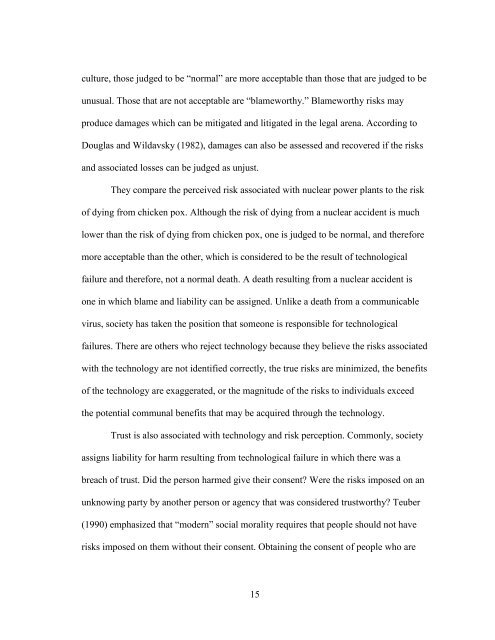PERCEIVED RISK AND THE SITING OF A CONTROVERSIAL ...
PERCEIVED RISK AND THE SITING OF A CONTROVERSIAL ...
PERCEIVED RISK AND THE SITING OF A CONTROVERSIAL ...
Create successful ePaper yourself
Turn your PDF publications into a flip-book with our unique Google optimized e-Paper software.
culture, those judged to be “normal” are more acceptable than those that are judged to be<br />
unusual. Those that are not acceptable are “blameworthy.” Blameworthy risks may<br />
produce damages which can be mitigated and litigated in the legal arena. According to<br />
Douglas and Wildavsky (1982), damages can also be assessed and recovered if the risks<br />
and associated losses can be judged as unjust.<br />
They compare the perceived risk associated with nuclear power plants to the risk<br />
of dying from chicken pox. Although the risk of dying from a nuclear accident is much<br />
lower than the risk of dying from chicken pox, one is judged to be normal, and therefore<br />
more acceptable than the other, which is considered to be the result of technological<br />
failure and therefore, not a normal death. A death resulting from a nuclear accident is<br />
one in which blame and liability can be assigned. Unlike a death from a communicable<br />
virus, society has taken the position that someone is responsible for technological<br />
failures. There are others who reject technology because they believe the risks associated<br />
with the technology are not identified correctly, the true risks are minimized, the benefits<br />
of the technology are exaggerated, or the magnitude of the risks to individuals exceed<br />
the potential communal benefits that may be acquired through the technology.<br />
Trust is also associated with technology and risk perception. Commonly, society<br />
assigns liability for harm resulting from technological failure in which there was a<br />
breach of trust. Did the person harmed give their consent? Were the risks imposed on an<br />
unknowing party by another person or agency that was considered trustworthy? Teuber<br />
(1990) emphasized that “modern” social morality requires that people should not have<br />
risks imposed on them without their consent. Obtaining the consent of people who are<br />
15
















